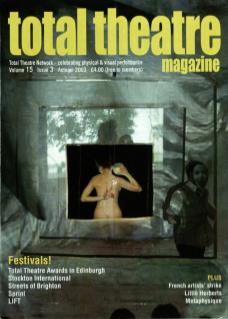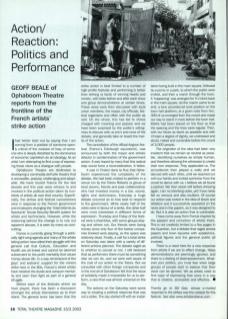I had better start out by saying that I am coming from a position of someone openly critical of the invasion of Iraq; of someone who is deeply disturbed by the dominance of economic capitalism as an ideology. As an artist I am attempting to find a way of expressing these views as a dialogue with people.
Ophaboom Theatre are dedicated to developing a commedia dell'arte theatre that is accessible, popular, challenging and adaptable. We have toured France for the last decade and this year were witness to and involved in the political action taken by hundreds of artists all over that country. Superficially, the strikes and festival cancellations were in response to the French government and employers changing the Intermittents du Spectacle Social Security Benefit system for artists and technicians. However, while the reasoning behind the change is to rule out apparent abuses, it is seen by many as cost-cutting.
France is currently going through a politically right-wing agenda and many of the artists taking action have allied their struggle with the general call that Culture, Education and Health are all linked and cannot be deemed subservient to the profit mentality that values money above life. In a way reminiscent of the gays' and lesbians' support for the miners strike here in the 80s, France's street artists have resisted the divide and conquer mentality and seen their fight as part of a general struggle.
Before each of the festivals where we have played, there has been a discussion amongst the artists themselves as to their stand. The general tenor has been that the strike action is best limited to a number of high-profile festivals and performing is better than striking (a tactic of winning hearts and minds), with talks before and after each show and group demonstrations at certain times. These views were then discussed with local union members, the mayor, city officials, festival organisers and often with the public as well. On the whole, this has led to shows charged with meaning and passion and we have been surprised by the public's willingness to discuss with us pros and cons of the debate, and generally take on board the merits of the action.
The cancellation of the official Avignon festival (France's Edinburgh equivalent) was announced by both the mayor and artistic director in condemnation of the government action. It was hoped by many that this radical step would force a reconsideration. It failed.
It was in Chalon dans la Rue that Ophaboom experienced the complexity of the debate. We had been invited to perform in a venue run by the Totors Roberts (a group of local clowns, friends and past collaborators) who had invested money in a bar, sound, lights and technicians. Every day a huge debate occurred as to how best to respond to the government. While nearly half of the votes were in favour of a strike, the other half were more interested in different forms of expression. Thursday and Friday of the festival were a shambles, with some groups playing and others not. Our friends were losing money since only four of the twelve companies booked were playing, so the space was relatively dead. Finally, a call for a total strike on Saturday was taken with a variety of different actions planned. The debate raged as to whether to cancel or not. I still believed that as performers there must be something else we can do, and we were well aware of the cost of our action to the Totors. But we consulted with other foreign companies and in the end all of Ophaboom felt that the issue of solidarity made it impossible for us to perform, a view that was almost universal on the day.
The actions on the Saturday went some way to creating a political response that was not a strike. The day started off with an installation being built in the main square, followed by a picnic in a park, to which the public were invited, and then a march through the town. A ‘happening’ was arranged for 5 o'clock back in the main square. As the march came to an end, a lone accordionist took position on the town hall platform; at a given note from him 300 of us emerged from the crowd and made our way to stand in rows before the town hall. Marks had been placed on the floor so that the spacing and the lines were regular. Then, with our faces as blank as possible and with (I hope) a degree of dignity, we undressed and stood, naked and vulnerable before the crowd of 3000 people.
The originator of the idea had been very insistent that we remain as neutral as possible, identifying ourselves as simply human, and therefore allowing the witnesses to create their own response. They applauded us. The accordionist then played a waltz and we danced with each other, until we reached out with our hands and invited someone from the crowd to dance with us. I believe we all found a partner. We then stood still before dressing again. I am no shrinking violet, yet I have rarely felt so nervous and also exultant. Of course our action was rooted in the idea of shock and titillation and it successfully appeared on the news and in the papers, as it was designed to do. But it is also an action that is vulnerable.
I have come away from France inspired by the passion and conviction of artists there. This is not creativity limited to a few pages in the Guardian, but a debate that raged across papers and town squares with academics, political figures and the general public all involved.
There is a need here for a new response from artists if we are to effect change. Mass demonstrations are seemingly ignored, and there is a feeling of disempowerment. Whatever your politics, you must fear when large groups of people start to believe that their voice can be ignored. We as artists need to find ways of expressing that voice in a way that is creative, accessible and effective.
Thanks go to Bill Gee, whose e-mailed response to the strikes was the catalyst for this feature. See also www.artsdanslarue.com

